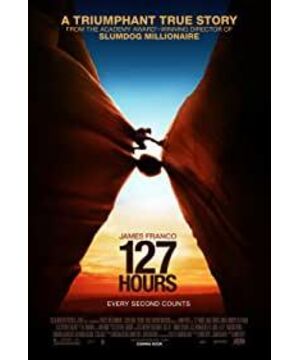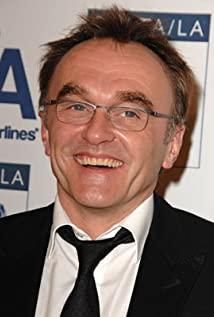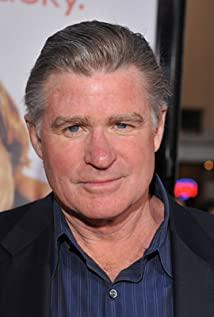This is the story of the American movie "127 Hours" adapted from real facts. It can be summarized in a few simple sentences. With a scene, a character, a few props, and a story without suspense, the whole movie leaves the audience with only one question: what perspective the director should take and what technique should be used to shoot such a simple content and lack of imagination. work. The producer hired Danny Bowie, the director of "Poor Millionaires", to be in charge of this film. It was actually a very good choice. In fact, Danny Bowie did make extensive use of his work in "Poor Millions". The elements in "The Rich Man" revitalized the "boring" film "127 Hours".
■Dynamic, fast, and glamorous
Judging from the original novel, "127 Hours" and "Poor Millionaire" stand at two extremes. The story and time span of "127 Hours" is very brief, and the focus is only on the suffering and courage of a single individual; "The Poor Millionaire" is extremely complicated, and the time spans the protagonist’s decades of childhood to adulthood. , And the meaning reflects the poverty and oppression endured by the majority of Indians. However, the director handled these two completely different scripts in a similar way, and achieved similar commercial effects.
The difficulty of translating the story of "127 Hours" into the movie is that the scenes, characters, and events are very limited. A young mountaineer is trapped in a narrow mountain crevice. It is a brown rock wall. In comparison, "Leaves on a Deserted Island" starring Tom Hanks in 2000, the internal conditions are much better, there is a small island to explore, and countless FedEx parcels can be used. In order to balance the quiet, slow, and monochromatic nature of the story, director Danny Bowie went the other way, using dynamic, fast, and colorful techniques to create a lively overall atmosphere.
The
first problem that a dynamic vs. static film has to overcome is "stillness". A film with no one talking is absolutely stuffy. Remember Mr. Wilson, Tom Hanks’s good friend on the island in "Legend of a Deserted Island"? That Wilson volleyball? Tom Hanks pretends that the ball is a person and constantly talks to it to add dialogue to the film. In "127 Hours", the design of the film is for the protagonist to carry a body camcorder, so the protagonist can continue to speak while filming himself, splitting the entire film.
The protagonist talking to himself and trying to save himself is certainly not enough to fill all the blanks in the story. Other parts must rely on "memory", "fantasy" and "illusion" to create the plot. Recalling the warmth of being with your lover in the past, the beauty of the fantasy food and drink entrance, the illusion of death and the fear of relatives and friends around you, these bridges not only bring other characters into the film, enrich the content and emotional atmosphere of the film, but also through the reality The unchanging dilemma and the cross-planting of fantasy fragments in the environment, the tone of the film has its ups and downs. The protagonist in the
fast vs. slow
movie is trapped for five days and five nights and cannot move, so time passes very slowly. If the director pushes and pulls and switches the camera slowly at this moment, the film will give people a heavy feeling, so the director chooses to use it very fast The speed to schedule the shots. When the lens switched from reality to fantasy and memory, Danny Bowie quickly dragged the focal length from the protagonist out of the slit, and pulled it all the way to the distant imaginary scene. This technique not only injects "fast" into the film Feeling, it also strongly injects the illusion of "escape from the slit and gain freedom" into the audience, which perfectly balances the discomfort of "slowness" and "limitation".
Colorful vs Monochrome
Due to the limitations of the background environment, a large number of close-up shots are inevitable. Compared with the long depth of field and high focus technique that most directors would choose, Danny Bowie chose to use many close-up shots to magnify part of the object to fill the entire screen. The advantage of this treatment is to exclude the single brown rock wall, so that the color of the object itself is full of the visual experience of the audience. For example, in the movie, the changes in drinking water are shot from the bottom of the blue transparent water bottle upwards. First, the transparent water decreases rapidly, and then the yellow urine suddenly increases. This technique not only illustrates the protagonist’s dilemma from drinking water to drinking urine, but also Because of the close-up, the proportion of blue has been enlarged and the rate of change in water volume has been accelerated.
The director also focused on shooting the changes in the sun every day. In a day, the position of the protagonist can shine with more than ten minutes of sunlight. This sunlight not only symbolizes hope and warmth, but also brings bright tones to the slits. In addition, the film also uses the method of splitting the screen, and the three screens are juxtaposed on the screen at the same time. On the one hand, it naturally emphasizes the changes in the protagonist’s mood at different stages, and on the other hand, it increases the color of the picture. Sense and variability.
■High degree of commercial perspective
. Generally speaking, there are several choices in the selection of the perspective of shooting the film "127 Hours": the smallness and fragility of human beings in nature, the inner struggle of human beings in life and death, and the face of death. The fear and loneliness of the time, or the strength and bravery shown in order to survive. Judging from the shooting techniques and atmosphere creation used by director Danny Bowie, his perspective is "not boring."
The overall tone of "127 Hours" is sunny and optimistic. The director used the first ten minutes of the film to explain the character characteristics of the protagonist. A handsome, optimistic, lively and outgoing young man who is not afraid of setbacks and is willing to help others. This tone continued for ten minutes. Although the hallucinations of the dead had also occurred, the protagonist never doubted whether he could survive, nor did he have any desperate thoughts. A large number of shooting techniques in the film are creating an atmosphere that is not dull, not limited, not lonely, and not boring. Even when the protagonist’s broken arm is close-up, the feelings of fear and pain are not presented, even brave. It is neither the feeling nor the determination, but a pure and strong without fear, doubt, or giving up.
In general, the director Danny Bowie's skill is still outstanding for being able to shoot stories like "127 Hours" without dullness and bloodshed. But just like "The Poor Millionaire", "127 Hours" is not a deep work. It has a relatively strong commercial color, and it follows a route that is more pleasing to the public. Although "Poor Millionaire" won the Oscar for Best Picture and Best Director in 2008, my personal evaluation of this film is not high. In the original work, behind every question that the protagonist answers correctly is the unspeakable sadness and pain of the Indian people. The protagonist’s final victory is with blood and tears, but in the film, behind the playful and cheerful atmosphere, what the audience sees It is the lovers who finally get married, it is the young couple who has overcome the test and brought down the evil organization... Anyway, as far as the American film industry is concerned in recent years, "Poor Millionaire" is already outstanding enough, as for "127 Hours." , It's not ugly.
View more about 127 Hours reviews









